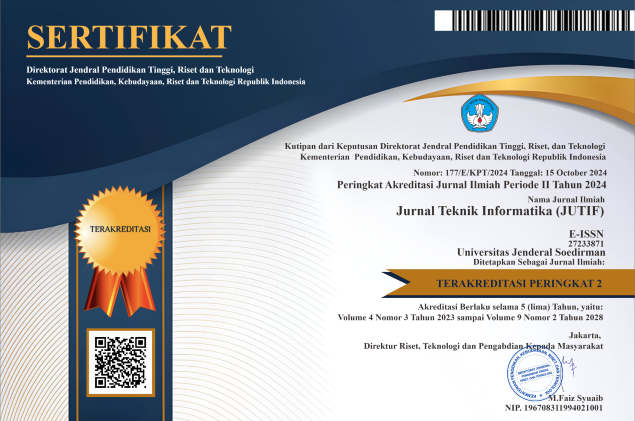Analyzing ChatGPT’s Impact on Graduates’ Communication, Collaboration, and Logical Thinking Skills Using an Extended Technology Acceptance Model
DOI:
https://doi.org/10.52436/1.jutif.2025.6.4.4688Keywords:
Artificial Intelligence, ChatGPT, Communication Skills, Critical Thinking, Soft Skills DevelopmentAbstract
The rapid rise of ChatGPT in Indonesia—now the third-highest user base worldwide—raises questions about its impact on essential soft skills for new graduates. Recent evidence warns that while ChatGPT supports academic and professional tasks, it may also reduce critical thinking, collaboration, and communication if not properly guided. This study aims to evaluate how ChatGPT usage affects communication, collaboration, and logical thinking skills among recent graduates in Jabodetabek. A cross-sectional survey of 384 respondents was conducted, and data were analyzed using Partial Least Squares Structural Equation Modeling (PLS-SEM). The modified Technology Acceptance Model (TAM) demonstrated strong explanatory power, with R² values of 0.830 for Behavioral Intention, 0.699 for Actual Use, and 0.651 for Attitude Toward Use. Hypothesis testing confirmed significant effects, including Perceived Ease of Use on Perceived Usefulness (β = 0.946; t = 172.023; p < 0.001) and Behavioral Intention on Actual Use (β = 0.836; t = 50.416; p < 0.001). Positive attitudes toward ChatGPT were strongly associated with enhanced teamwork, communication, and logical reasoning. This study contributes to the discourse on digital literacy and educational technology in Southeast Asia, demonstrating that ChatGPT can strengthen graduate employability when integrated with proper guidance and ethical use. The findings provide practical implications for computer science and education fields, offering a framework for balancing AI adoption with the preservation of critical human skills.
Downloads
References
X. Lin, K. Luterbach, K. H. Gregory, and S. E. Sconyers, “A Case Study Investigating the Utilization of ChatGPT in Online Discussions,” Online Learn. J., vol. 28, no. 2, pp. 1–23, 2024, doi: 10.24059/olj.v28i2.4407.
E. Kasneci et al., “ChatGPT for good? On opportunities and challenges of large language models for education,” Learn. Individ. Differ., vol. 103, p. 102274, 2023, doi: https://doi.org/10.1016/j.lindif.2023.102274.
M. Sallam, N. A. Salim, M. Barakat, and A. B. Al-Tammemi, “ChatGPT Applications in Medical, Dental, Pharmacy, and Public Health Education: A Descriptive Study Highlighting The Advantages and Limitations,” Narra J., vol. 3, no. 1, pp. 1–14, 2023, doi: https://doi.org/10.52225/narra.v3i3.255.
A. A. Jairoun, S. S. Al-Hemyari, M. Shahwan, G. R. Alnuaimi, N. Ibrahim, and A. A. S. Jaber, “Capturing pharmacists’ perspectives on the value, risks, and applications of ChatGPT in pharmacy practice: A qualitative study,” Explor. Res. Clin. Soc. Pharm., vol. 16, no. September, p. 100518, 2024, doi: 10.1016/j.rcsop.2024.100518.
A. Kavadella, M. A. D. Da Silva, E. G. Kaklamanos, V. Stamatopoulos, and K. Giannakopoulos, “Evaluation of ChatGPT’s Real-Life Implementation in Undergraduate Dental Education: Mixed Methods Study,” JMIR Med. Educ., vol. 10, no. 1, 2024, doi: 10.2196/51344.
P. Smutny and P. Schreiberova, “Chatbots for learning: A review of educational chatbots for the Facebook Messenger,” Comput. Educ., vol. 151, no. February, p. 103862, 2020, doi: 10.1016/j.compedu.2020.103862.
M. G. Hussein, “Exploring the Significance of Soft Skills in Enhancing Employability of Taif University Postgraduates: An Analysis of Relevant Variables,” SAGE Open, vol. 14, no. 3, pp. 1–17, 2024, doi: 10.1177/21582440241271941.
D. Johnson and R. Johnson, “Cooperative Learning: The Foundation for Active Learning,” S. M. D. R. Brito, Ed., Rijeka: IntechOpen, 2018. doi: 10.5772/intechopen.81086.
E. P. H. Choi, J. J. Lee, M.-H. Ho, J. Y. Y. Kwok, and K. Y. W. Lok, “Chatting or cheating? The impacts of ChatGPT and other artificial intelligence language models on nurse education,” Nurse Educ. Today, vol. 125, p. 105796, 2023, doi: https://doi.org/10.1016/j.nedt.2023.105796.
I. S. Axiak, P. A. Packer, and S. Ghio, “Integrating soft skill development with recruitment and retention strategies: the case of a small island state,” Strateg. HR Rev., vol. 23, no. 6, pp. 225–229, Jan. 2024, doi: 10.1108/SHR-07-2024-0048.
A. Dzhurylo, O. Hlushko, and O. Shparyk, “Innovative Approaches To Formulation and Development of Soft Skills of Secondary School Students in the Context of Ukraine’S Integration Into the European Education Area,” Educ. Mod. Discourses, no. 4, pp. 39–49, 2021, doi: 10.37472/2617-3107-2021-4-05.
H. Karimi and A. Pina, “Strategically Addressing the Soft Skills Gap Among STEM Undergraduates,” J. Res. STEM Educ., vol. 7, no. 1, pp. 21–46, 2021, doi: 10.51355/jstem.2021.99.
F. D. Davis, “Perceived Usefulness, Perceived Ease of Use, and User Acceptance of Information Technology,” MIS Q. Manag. Inf. Syst., vol. 13, no. 3, pp. 319–339, 1989, doi: https://doi.org/10.2307/249008.
Sugiyono, Metode Penelitian Bisnis, Pendekatan Kuantitatif, Kualitatiff, Kombinasi, dan R&D, Cet.3. Bandung: Alfabeta, 2022.
J. W. Creswell and J. D. Creswell, Research Design: Qualitative, Quantitative, and Mixed Methods Approaches. Thousand Oaks, CA: SAGE Publications, 2018.
G. W. Purnomo, “Pengujian UTAUT Model dalam Pemanfaatan Literasi Informasi Perpustakaan Perguruan Tinggi,” J. Ilm. Adm. Publik, vol. 5, no. 3, pp. 277–284, 2019, doi: 10.21776/ub.jiap.2019.005.03.3.
I. Ghozali and H. Latan, Konsep, Teknik, Aplikasi Menggunakan Smart PLS 3.0 Untuk Penelitian Empiris. Semarang: BP UNDIP, 2015.
R. J. Holden and B. T. Karsh, “The Technology Acceptance Model: Its past and its future in health care,” J. Biomed. Inform., vol. 43, no. 1, pp. 159–172, 2010, doi: 10.1016/j.jbi.2009.07.002.
V. Venkatesh and F. D. Davis, “Theoretical extension of the Technology Acceptance Model: Four longitudinal field studies,” Manage. Sci., vol. 46, no. 2, pp. 186–204, 2000, doi: 10.1287/mnsc.46.2.186.11926.
A. Mardhiah, N. Farisha, W. P. Yuan, and F. N. Tony, “Investigating the Influence of Perceived Ease of Use and Perceived Usefulness on Housekeeping Technology Intention to Use,” Int. J. Acad. Res. Bus. Soc. Sci., vol. 12, no. 11, pp. 1306–1314, 2022, doi: 10.6007/ijarbss/v12-i11/15657.
M. Amin, S. Rezaei, and M. Abolghasemi, “User satisfaction with mobile websites: the impact of perceived usefulness (PU), perceived ease of use (PEOU) and trust,” Nankai Bus. Rev. Int., vol. 5, no. 3, pp. 258–274, Jan. 2014, doi: 10.1108/NBRI-01-2014-0005.
M. N. Al-Suqri, “Perceived usefulness, perceived ease-of-use and faculty acceptance of electronic books,” Libr. Rev., vol. 63, no. 4/5, pp. 276–294, Jan. 2014, doi: 10.1108/LR-05-2013-0062.
H. A. Ismail, “Intention to Use Smartphone Through Perceived Compatibility, Perceived Usefulness, and Perceived Ease of Use,” J. Din. Manaj., vol. 7, no. 1, p. 1, 2016, doi: 10.15294/jdm.v7i1.5748.
D. S. Alfani, A. Yuniarto, and R. P. Handrito, “the Effect of Perceived Ease of Use on Intention To Use on Bank Syariah Indonesia Mobile Banking Users Is Mediated By E-Trust and Religiosity As Moderators,” Int. J. Econ. Business, Accounting, Agric. Manag. Sharia Adm., vol. 3, no. 4, pp. 1248–1259, 2023, doi: 10.54443/ijebas.v3i4.1024.
R. A. Putra, S. Ahmad, and F. M. Rahman, “The Influence of Perceived Usefulness and Perceived Ease of use on Behavioral Intention on Brimo Application Users in Bengkulu City,” J. Econ. Financ. Manag. Stud., vol. 06, no. 12, pp. 5917–5921, 2023, doi: 10.47191/jefms/v6-i12-18.
B. S. Zhang, K. Ali, and T. Kanesan, “A model of extended technology acceptance for behavioral intention toward EVs with gender as a moderator,” Front. Psychol., vol. 13, 2022, doi: 10.3389/fpsyg.2022.1080414.
A. Rahayu, S. Sulastri, L. . Wibowo, and V. Gaffar, “Effect of Technology Readiness Towards Acceptance Technology in Using Information System,” Proc. 6th Glob. Conf. Business, Manag. Entrep. (GCBME 2021), vol. 657, no. Gcbme 2021, pp. 553–557, 2022, doi: 10.2991/aebmr.k.220701.101.
S. Krisdina, O. D. Nurhayati, and D. M. K. Nugraheni, “Hybrid Model Based on Technology Acceptance Model (TAM) & Information System Success Model (ISSM) in Analyzing the Use of E-Health,” E3S Web Conf., vol. 359, 2022, doi: 10.1051/e3sconf/202235905003.
S. Y. Yousafzai, G. R. Foxall, and J. G. Pallister, “Technology acceptance: a meta‐analysis of the TAM: Part 2,” J. Model. Manag., vol. 2, no. 3, pp. 281–304, Jan. 2007, doi: 10.1108/17465660710834462.
J. Kim and H. A. Park, “Development of a health information technology acceptance model using consumers’ health behavior intention,” J. Med. Internet Res., vol. 14, no. 5, pp. 1–14, 2012, doi: 10.2196/jmir.2143.
H. G. Song and H. Jo, “Understanding the Continuance Intention of Omnichannel: Combining TAM and TPB,” Sustain., vol. 15, no. 4, pp. 1–21, 2023, doi: 10.3390/su15043039.
B. W. Wirtz and V. Göttel, “Technology acceptance in social media: Review, synthesis and directions for future empirical research,” J. Electron. Commer. Res., vol. 17, no. 2, pp. 97–115, 2016.
N. Marangunić and A. Granić, “Technology acceptance model: a literature review from 1986 to 2013,” Univers. Access Inf. Soc., vol. 14, no. 1, pp. 81–95, 2015, doi: 10.1007/s10209-014-0348-1.
P. Kowalczuk, “Consumer acceptance of smart speakers: a mixed methods approach,” J. Res. Interact. Mark., vol. 12, no. 4, pp. 418–431, 2018, doi: 10.1108/JRIM-01-2018-0022.
S. Yutdhana and K. N. Kohler, “Technology Acceptance among English Pre-service Teachers: A Path Analysis Approach,” English Lang. Teach., vol. 16, no. 6, p. 45, 2023, doi: 10.5539/elt.v16n6p45.
Y. Cao, A. A. Aziz, and W. N. R. M. Arshard, “University students’ perspectives on Artificial Intelligence: A survey of attitudes and awareness among Interior Architecture students,” Int. J. Educ. Res. Innov., vol. 2023, no. 20, pp. 1–21, 2023, doi: 10.46661/ijeri.8429.
H. Bala, V. Venkatesh, D. C. Ganster, and A. Rai, “How does an enterprise system implementation change interpersonal relationships in organizations,” Ind. Manag. Data Syst., vol. 121, no. 8, pp. 1824–1847, Jan. 2021, doi: 10.1108/IMDS-06-2020-0380.
A. H. Albashtawi and K. B. Al Bataineh, “The effectiveness of google classroom among EFL students in Jordan: An innovative teaching and learning online platform,” Int. J. Emerg. Technol. Learn., vol. 15, no. 11, pp. 78–88, 2020, doi: 10.3991/IJET.V15I11.12865.
Y. K. Dwivedi, N. Kshetri, L. Hughes, E. L. Slade, and ..., “… wrote it?” Multidisciplinary perspectives on opportunities, challenges and implications of generative conversational AI for research, practice and policy,” 2023, Elsevier. [Online]. Available: https://www.sciencedirect.com/science/article/pii/S0268401223000233
O. Zawacki-Richter and et al., “AI in Educational Technology,” J. Educ. Technol., vol. 40, no. 2, pp. 85–101, 2019.
Additional Files
Published
How to Cite
Issue
Section
License
Copyright (c) 2025 Raja Alan Hasri, Eka Miranda

This work is licensed under a Creative Commons Attribution 4.0 International License.



























